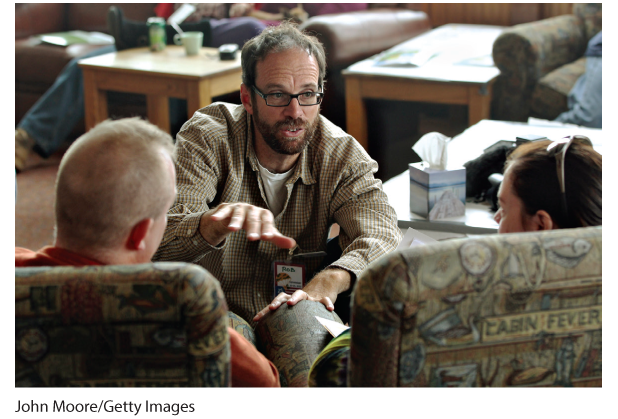Group and Family Therapies
Group Therapy
Except for traditional psychoanalysis, most therapies may also occur in small groups. Group therapy does not provide the same degree of therapist involvement with each client. However, it offers other benefits:
- It saves therapists’ time and clients’ money, and often is no less effective than individual therapy (Burlingame et al., 2016).
- It offers a social laboratory for exploring social behaviors and developing social skills. Therapists frequently suggest group therapy for people experiencing frequent conflicts or whose behavior distresses others. The therapist guides people’s interactions as they discuss issues and try out new behaviors.
- It enables people to see that others share their problems. It can be a relief to discover that others, despite their composure, experience some of the same troublesome feelings and behaviors (Ooi et al., 2016).
- It provides feedback as clients try out new ways of behaving. Hearing that you look poised, even though you feel anxious and self-conscious, can be very reassuring.
Family Therapy
One special type of group interaction, family therapy, assumes that no person is an island: We live and grow in relation to others, especially our families. We struggle to differentiate ourselves from our families, but we also need to connect with them emotionally. These two opposing tendencies can create stress for both the individual and the family.

Family therapy This type of therapy often acts as a preventive mental health strategy and may include marriage therapy, as shown here at a retreat for military families. The therapist helps family members understand how their ways of relating to one another create problems. The treatment’s emphasis is not on changing the individuals, but on changing their relationships and interactions.
Family therapists tend to view families as systems, in which each person’s actions trigger reactions from others. A child’s rebellion, for example, affects and is affected by other family tensions. Therapists are often successful in helping family members identify their roles within the family’s social system, improve communication, and discover new ways of preventing or resolving conflicts (Hazelrigg et al., 1987; Shadish et al., 1993).
Self-Help Groups
More than 100 million Americans have belonged to small religious, interest, or support groups that meet regularly—with 9 in 10 reporting that group members “support each other emotionally” (Gallup, 1994). One analysis of online support and self-help groups reported that most focus on stigmatized or hard-to-discuss illnesses (Davison et al., 2000). AIDS patients were 250 times more likely than hypertension patients to be in support groups. People with anorexia and alcohol use disorder often join groups; those with migraines and ulcers usually do not.
The grandparent of support groups, Alcoholics Anonymous (AA), reports having 2.1 million members in 118,000 groups worldwide. Its famous 12-step program, emulated by many other self-help groups, asks members to admit their powerlessness, to seek help from a higher power and from one another, and (the twelfth step) to take the message to others in need of it (Galanter, 2016). Studies of 12-step programs such as AA have found that they help reduce alcohol use disorder at rates comparable to other treatment interventions (Ferri et al., 2006; Moos & Moos, 2005). In an eight-year, $27 million investigation, AA participants reduced their drinking sharply, as did those assigned to CBT or an alternative therapy (Project Match, 1997). Another study of 2300 veterans who sought treatment for alcohol use disorder found that a high level of AA involvement was followed by diminished alcohol problems (McKellar et al., 2003). The more meetings AA members attend, the greater their alcohol abstinence (Moos & Moos, 2006). Those whose personal stories include a “redemptive narrative”—who see something good as having come from their struggles—more often sustain sobriety (Dunlop & Tracy, 2013).
In an individualist age, with more and more people living alone or feeling isolated, the popularity of support groups—for the addicted, the bereaved, the divorced, or simply those seeking fellowship and growth—may reflect a longing for community and connectedness.
* * *
For a synopsis of these modern psychotherapies, see Table 71.2.
| Therapy | Presumed Problem | Therapy Aim | Therapy Technique |
|---|---|---|---|
| Psychodynamic | Unconscious conflicts from childhood experiences | Reduce anxiety through self-insight. | Interpret patients’ memories and feelings. |
| Client-centered | Barriers to self-understanding and self-acceptance | Enable growth via unconditional positive regard, acceptance, genuineness, and empathy. | Listen actively and reflect clients’ feelings. |
| Behavior | Dysfunctional behaviors | Learn adaptive behaviors; extinguish problem ones. | Use classical conditioning (via exposure or aversion therapy) or operant conditioning (as in token economies). |
| Cognitive | Negative, self-defeating thinking | Promote healthier thinking and self-talk. | Train people to dispute negative thoughts and attributions. |
| Cognitive-behavioral | Self-harmful thoughts and behaviors | Promote healthier thinking and adaptive behaviors. | Train people to counter self-harmful thoughts and to act out their new ways of thinking. |
| Group and family | Stressful relationships | Heal relationships. | Develop an understanding of family and other social systems, explore roles, and improve communication. |